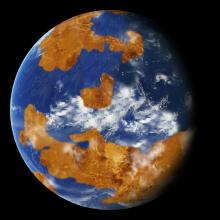Listen to today's episode of StarDate on the web the same day it airs in high-quality streaming audio without any extra ads or announcements. Choose a $8 one-month pass, or listen every day for a year for just $30.
You are here
Morning Venus
Ideas about the planet Venus are sort of like children on a seesaw: up, then down; up, then down.
Astronomers have known for a long time that Venus is covered by clouds. Until the 1960s, that raised the possibility that the surface was covered by oceans and steamy jungles, both teeming with life. That’s up.
As spacecraft began visiting Venus, though, we learned that the clouds are made of sulfuric acid, and conditions below them are hellish. The atmosphere is made of carbon dioxide, it’s dense enough to squish living organisms, and it’s hot enough to melt lead. That’s down.
Then, a few decades ago, evidence began to suggest that Venus had been covered by oceans for as long as two billion years. That would have created a comfortable home for life. Back up.
But a study released last year said that Venus was never cool enough to form oceans, so it’s always been hot and dry. Back down.
Our knowledge of the planet’s past is limited, though, because probes have barely touched the surface. Missions scheduled for the next decade or so should spend more time exploring the surface. Their findings could tilt the seesaw once more — but in which direction is still a mystery.
And Venus has tilted up into view in the dawn sky. It’s the brilliant “morning star,” low in the southeast at first light. Right now, fainter Mars is close to the lower right of Venus — another world with its ups and downs. But that’s a tale for another day.
Script by Damond Benningfield





